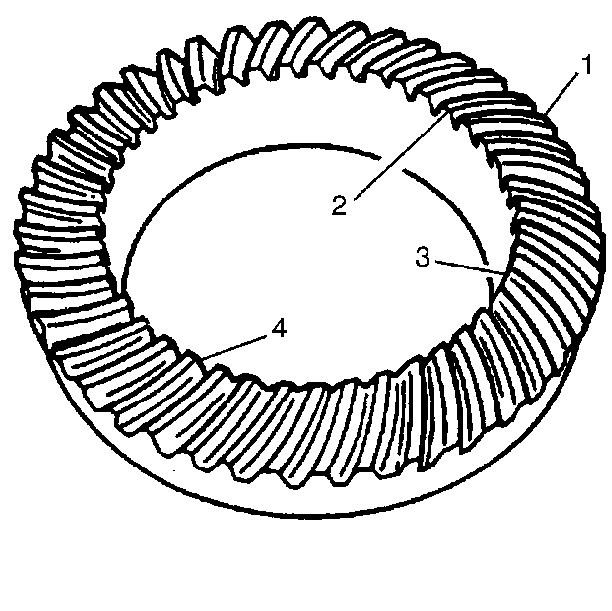Before the final assembly of the differential, a gear tooth contact pattern check should be performed.
A gear tooth contact pattern check is NOT a substitute for adjusting the pinion depth and the backlash. The gear tooth contact pattern check is a final check in order to verify the correct running position of the ring gear and the drive pinion. Any gear sets which are not aligned properly may be noisy and have a short life. With a pattern check, the best contact between the ring gear and the drive pinion for low noise level and long life can be ensured.
Gear Tooth Terms

The side of the ring gear tooth which curves outward, or is convex, is the DRIVE side (4). The concave side is the COAST side (3). The end of the tooth nearest center of the ring gear is the TOE end (2). The end of the tooth farthest away from the center is the HEEL end (1). The toe end of the tooth is smaller than the heel end.
Testing Procedure
- Wipe the oil out of the carrier.
- Apply gear marking compound sparingly to all ring gear teeth using a medium stiff brush.
- Using a torque wrench, apply a load until a torque of 13 N·m (9.6 lb ft) is required to turn the pinion.
- Observe the pattern on the ring gear teeth.
Carefully clean each tooth of the ring gear.
When properly used, the area of pinion tooth contact will be visible when hand load is applied.
| • | A test that is made without loading the gears will not give a satisfactory pattern. |
| • | Turn the companion flange with a wrench so that the ring gear rotates six full revolutions. |
| • | Then reverse the rotation so that the ring gear rotates six revolutions in the opposite direction. |
| • | Excessive turning of the ring gear is not recommended. |
Adjustments Affecting Tooth Contact
There are two adjustments, backlash and pinion depth, which will affect the tooth contact pattern. The effects of the bearing preloads are not easily seen on hand loaded teeth pattern tests. Make the adjustments within specifications before proceeding with the backlash and the drive pinion adjustments.
Adjust the pinion depth and the backlash as necessary, in order to obtain the correct pattern.
The pinion depth is adjusted by increasing or decreasing the shim thickness between the pinion head and the inner race of the rear bearing. The shim is used in the differential in order to compensate for the manufacturing tolerances. Increasing the shim thickness will move the pinion closer to the centerline of the ring gear.
The backlash is adjusted by means of the side bearing adjusting sleeves which move the entire case and the ring gear assembly closer to, or farther from the drive pinion. The adjusting sleeves are also used in order to set side the bearing preload. In order to increase the backlash, turn the left sleeve in and turn the right sleeve out an identical amount. In order to decrease the backlash, turn the right sleeve in and turn the left sleeve out an identical amount.
The contact pattern must be centrally located up and down on the face of the ring gear teeth.
